Papers by Mehmet Fatih ORHAN

Turkiye Cocuk Hastalıkları Dergisi, Sep 10, 2012
Physical restraints are used to prevent from giving harm themselves and to perform medical care a... more Physical restraints are used to prevent from giving harm themselves and to perform medical care and treatment options in intensive care units. This study has been designed for observing knowledge, manner, and practice level of pediatric intensive care nurses and for examining the factors that affect this practice. Scale of Suen has been used for this study. When the level of the knowledge was analyzed for all nurses, the level of knowledge has been higher for male nurses than that of the females. On the contrary, there was no difference between attitude and behaviours of male and female nurses. Among all nurses, 76.2% of them do not feel guilty because of the usage of physical restraints. In the assessment of behavior, we have found that 33% of the nurses use the physical restraints as independent nursing facilities. The level of knowledge and maintaining positive attitude on usage of physical restraints are at intermediate levels, whereas our nurses act more positive. Nowadays, since patient rights have more effective than the past, we must study in this field in order to protect nurses and their patients.
Marmara Medical Journal, 2024
MYH9-related diseases in the differential diagnosis of chronic immune thrombocytopenic purpura
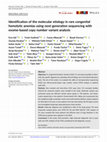
European Journal of Haematology, 2024
Objectives: In congenital hemolytic anemias (CHA), it is not always possible to determine the spe... more Objectives: In congenital hemolytic anemias (CHA), it is not always possible to determine the specific diagnosis by evaluating clinical findings and conventional laboratory tests. The aim of this study is to evaluate the utility of next-generation sequencing (NGS) and clinical-exome-based copy number variant (CNV) analysis in patients with CHA. Methods: One hundred and forty-three CHA cases from 115 unrelated families referred for molecular analysis were enrolled in the study. Molecular analysis was performed using two different clinical exome panels in 130 patients, and wholeexome sequencing in nine patients. Exome-based CNV calling was incorporated into the traditional single-nucleotide variant and small insertion/deletion analysis pipeline for NGS data in 92 cases. In four patients from the same family, the PK Gypsy variant was investigated using long-range polymerase chain reaction. Results: Molecular diagnosis was established in 86% of the study group. The most frequently mutated genes were SPTB (31.7%) and PKLR (28.5%). CNV analysis of 92 cases revealed that three patients had different sizes of large deletions in the SPTB and six patients had a deletion in the PKLR. Conclusions: In this study, NGS provided a high molecular diagnostic rate in cases with rare CHA. Analysis of the CNVs contributed to the diagnostic success.
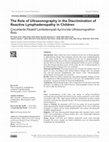
The Journal of Current Pediatrics, 2024
Giriş: Lenfadenopatiye (LAP) neden olan benign ve malign hastalıkların ayrımında ultrasonografini... more Giriş: Lenfadenopatiye (LAP) neden olan benign ve malign hastalıkların ayrımında ultrasonografinin rolü üzerine birçok çalışma yapılmıştır. Ancak reaktif etiyolojilere bağlı LAP'ı diğer benign enfeksiyöz nedenlerden ayırmaya yönelik çalışmalar yetersizdir. Bu çalışmada benign LAP'lerin ayrımında ultrasonografinin rolü incelenmiştir. Gereç ve Yöntem: Bu çalışmada LAP'li 0-18 yaş grubu 165 çocuk prospektif olarak değerlendirildi. Klinik özelliklerine göre benign LAP'ler viral ve bakteriyel lenfadenit ve reaktif LAP'ler olarak gruplandırıldı. Her grubun ultrasonografik özellikleri değerlendirildi. Bulgular: LAP'larin ultrasonografik bulgularından hiler ekojenite kaybı, reaktif LAP'ı viral lenfadenitten ayırmada anlamlı iken, sınır düzensizliği bakteriyel lenfadenit için daha anlamlıydı. Sonuç: Benign LAP'lerin ayırt edilmesi antibiyotik reçete etme kararında önemlidir. Bu ayrımı yapmak için klinik özelliklerin yanı sıra ultrasonografik özelliklerden de yararlanılabilir.
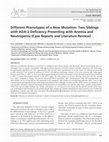
Asthma Allergy Immunology, 2023
Deficiency of adenosine deaminase 2 (DADA2) is a childhood-onset disease known with pleiotropic c... more Deficiency of adenosine deaminase 2 (DADA2) is a childhood-onset disease known with pleiotropic clinical manifestations due to a monogenic form of systemic vasculopathy. Although the clinical spectrum of DADA2, linked to biallelic mutations in the ADA2 gene, has significantly expanded since 2014, approximately 200 cases have been reported thus far. In this report, two siblings are presented to draw attention to an unreported mutation of DADA2 and different phenotypic features of the same missense type homozygous mutation, p.Ser50Leu (c.149C>T). Next-generation sequencing demonstrated an autosomal recessive inherited missense type p.Ser50Leu (c.149C>T) variant homozygous mutation in the ADA-2 gene. The index patient is a 10-year-old Iraqi citizen boy who was referred to us with a complaint of anemia. The patient still needed blood transfusions after 2 hematopoietic stem cell transplantations. His older brother was an 11-year-old boy who presented to the emergency with a history of recurrent lung infections since 7 years of age. Considering the genotype-phenotype relationship from literature data, although vasculitis and low ADA2 activity are defined in cases with missense mutations, immuno-hematological manifestations are remarkable in our patients rather than vasculitic manifestations. While bone marrow failure findings e.g., anemia, neutropenia, etc. are reported to be seen in the 5th and 6th decades of life, those were predominant clinical features in our patients despite their younger age. DADA2 should also be kept in mind in cases of otherwise unexplained cytopenia, especially when associated with panhypogammaglobulinaemia and bone marrow hypocellularity, irrespective of the age of the patient at presentation.
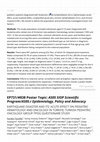
Pediatric Blood & Cancer, 2023
Abstracts from the 55th Congress of the International Society of Paediatric Oncology (SIOP)
EP731... more Abstracts from the 55th Congress of the International Society of Paediatric Oncology (SIOP)
EP731/#838 Poster Topic: AS05 SIOP Scientific Program/AS05.r Epidemiology, Policy and Advocacy
Background and Aims: The earthquake disaster that occurred in 11 provinces of Turkey on February 6, 2023, affected all life. Patients with special needs like chilhood cancers and their doctors also affected. Our goal is to understand what we have lived, as PHO, how we handle the problems and understand special needs to be stronger and prepare such disasters.
Methods: A questionnaire has been send to TPOG members with 17 questions reliated to themselves and their families health conditions, their home, hospitals, patients, working and living conditions after 1 month of erthquake. Beside received their recommandations to be stronger and ready for the future possible disasters as PHO.
Results: Forty one Pediatric Hematologist/Oncologist (PHO) responded the questionnaire from 18 cities. 50% of the PHO that living outside of the earthquake cities have family members living at the earthquake region. Nine doctors that living at the earthquake region were able to quit their home while 1 had diffuculty to goout. Three of the doctors had damage at their homes. Seven of the doctors accommodated at tents, cars, hospitals or the their friends home. Eight of the doctors hospitals were damaged/collapsed. One of them worked at tent while others worked at solid buildings of the hospitals. Five doctors told they lost some patients while 60 % did not loose any and 30% did not know yet. Five doctors referred their patients to the other centers outside of the earthquake region or some bigger/solid hospitals near by themselves. 72% of the centers have received referral patients. Some of these patients accommadated at the hospitals, tents, dormitories and/or with their relatives.
Conclusions: As pediatric hematologist and oncologist, taking care of patient with special needs, we have to be prepared for disasters. For better coordination, we have to take place in the emergency management plan groups as PHO.
Olgularla Hemolitik Anemi, 2023

Pediatric Blood & Cancer, 2023
Background: In patients with acute lymphoblastic leukemia (ALL), the risk of thromboembolism incr... more Background: In patients with acute lymphoblastic leukemia (ALL), the risk of thromboembolism increases due to hemostatic changes secondary to the primary disease and due to treatment-related factors. In this multicenter study, we aimed to research the frequency of central nervous system (CNS) thrombosis occurring during treatment, hereditary and acquired risk factors, clinical and laboratory features of patients with thrombosis, treatment approaches, and thrombosis-related mortality and morbidity rates in pediatric ALL patients. Procedure: Pediatric patients who developed CNS thrombosis during ALL treatment from 2010 to 2021 were analyzed retrospectively in 25 different Pediatric Hematology Oncology centers in Türkiye. The demographic characteristics of the patients, symptoms associated with thrombosis, the stage of the leukemia treatment during thrombosis, the anticoagulant therapy applied for thrombosis, and the final status of the patients recorded through electronic medical records were determined. Results: Data from 70 patients with CNS thrombosis during treatment, out of 3968 pediatric patients with ALL, were reviewed. The incidence of CNS thrombosis was 1.8% (venous: 1.5 %; arterial: 0.03%). Among patients with CNS thrombosis, 47 had the event in the first 2 months. Low molecular weight heparin (LMWH) was the most commonly used treatment with a median of 6 months (min-max: 3-28 months). No treatment-related complications occurred. Chronic thrombosis findings occurred in four patients (6%). In five (7%) patients who developed cerebral vein thrombosis, neurological sequelae (epilepsy and neurological deficit) remained. One patient died related to thrombosis, and the mortality rate was 1.4%. Conclusion: Cerebral venous thrombosis and, less frequently, cerebral arterial thrombosis may develop in patients with ALL. The incidence of CNS thrombosis is higher during induction therapy than during other courses of treatment. Therefore, patients receiving induction therapy should be monitored carefully for clinical findings suggestive of CNS thrombosis.

The effect of early and long-term propranolol therapy on learning and memory in mice, 2023
Propranolol is the treatment of choice for infantile hemangioma. We investigated the effects of l... more Propranolol is the treatment of choice for infantile hemangioma. We investigated the effects of long-term propranolol use in early infancy on learning and memory later in life in mice. At three weeks of age, mice were randomly divided into six experimental groups. Groups 1 and 2 (controls) received only saline for 21 days. Groups 3 and 4 received propranolol (2.5 mg/kg) for 21 days. Groups 5 and 6 received propranolol (5 mg/kg) for 21 days. Groups 1, 3 and 5 were tested at the end of 21 days of treatment (week 6). However, groups 2, 4 and 6 received a 2-week break and then (week 8) exposed to tests. In the Morris water maze test, propranolol (2.5 and 5 mg/kg) dose-dependently increased the time spent in the target quadrant in mice at weeks 6 and 8. However, propranolol did not affect the swimming speed in both time periods. There were no significant effects of propranolol on the number of errors evaluated during the radial arm maze tests. In conclusion, long-term use of propranolol in early infancy did not disrupt the learning and memory of mice.
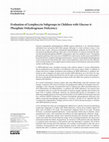
Evaluation of Lymphocyte Subgroups in Children with Glucose-6- Phosphate Dehydrogenase Deficiency, 2023
Glucose-6-phosphate dehydrogenase (G6PD) enzyme deficiency is an inherited disease estimated to b... more Glucose-6-phosphate dehydrogenase (G6PD) enzyme deficiency is an inherited disease estimated to be carried by 400 million people. Although it is more common in boys, it can also be seen in girls. 1 Glucose-6-phosphate dehydrogenase catalyzes the first reaction in the pentose phosphate pathway, takes part in the formation of reduced nicotinamide adenine dinucleotide phosphate (NADPH), and protects cells from oxidative stress. The pentose phosphate pathway is the only source of NADPH for erythrocytes. Erythrocytes need G6PD to be protected from oxidative damage and hemolysis. 2 Glucose-6-phosphate dehydrogenase is also necessary for other blood cells, and in case of deficiency, these cells are also affected. There are few studies on this subject and its clinical results in the literature, and some of them contain conflicting results.

A Decision Support System For Detecting Stage In Hodgkin Lymphoma Patients Using Artificial Neural Network and Optimization Algorithms, 2022
Hodgkin-type lymphoma is a disease with unique histological, immunophenotypic, and clinical featu... more Hodgkin-type lymphoma is a disease with unique histological, immunophenotypic, and clinical features. This disease occurs in nearly 30% of all lymphomas. Its treatable is high. However, the treatment plan is specified after the stage and risk status are determined. For this reason, it is an important process for doctors to decide on the stage of the disease correctly. Some of the data used for this decision are the patient's history, detailed physical examination, laboratory findings, imaging methods and bone marrow biopsy results. Hybrid FDG-PET is an important imaging method used in the medical world. This method is used in diagnosis, evaluation of response given to treatment, staging and restaging process. However, it is radiation-based. Therefore it has the possibility of producing undesirable results in the future. In this study, an artificial intelligence-based computer-assisted decision support system is done to reduce the number of used medical methods and radiation exposure. Data were obtained from the NCBI-GEO dataset. The evaluation of these data, which contains missing values, is handled in two ways. Firstly, samples with missing values in the initial evaluation are deleted from the dataset. Then, these data are trained with "trainlm" function in artificial neural network architecture. However, reducing the error value of the estimates is important. For this, the artificial neural network architecture is retrained with the artificial bee colony algorithm, particle swarm optimization algorithm and invasive weed algorithm, respectively. Secondly, the same operations are performed again on the dataset containing missing values. As a result of the training, the maximum performance was obtained for invasive weed and particle swarm optimization algorithms with 1,45547E+14 and 1,23103E+14 average error rates, respectively.
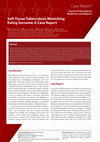
Soft Tissue Tuberculosis Mimicking Ewing Sarcoma: A Case Report, 2022
Mycobacterium tuberculosis is a disease seen in every tissue and organ. Although it often involve... more Mycobacterium tuberculosis is a disease seen in every tissue and organ. Although it often involves the lung and pleura, it can also progress into extrapulmonary tuberculosis. Soft tissue and bone tuberculosis are the least common of all tuberculosis types. In some cases, the lesions may appear like bone tumors or metastatic lesions. Bacteriological and histopathological studies reach a definitive diagnosis because of the biopsy. We present a case suggestive of Ewing's sarcoma with clinical and imaging findings but diagnosed as soft tissue tuberculosis resulting from the biopsy. A two-year-old girl was admitted to our clinic with the complaint of palpable swelling on the left side of her chest. Ewing sarcoma was considered with the findings of Computed Tomography (CT), Magnetic Resonance Imaging (MRI), and PET-CT. Biopsy material was reported as casefied granulomatous inflammation, and M. tuberculosis complex DNA was detected by PCR examination of the tissue. The patient was successfully treated with rifampin, isoniazid, pyrazinamide, and ethambutol. Today, it should be kept in mind that tuberculosis is a common disease, rarely isolated soft tissue or bone involvement, and can be confused with malignancy.

Hematology, Transfusion and Cell Therapy, 2021
Objective: A questionnaire form was prepared by the Turkish Pediatric Hematology Society- Subcomm... more Objective: A questionnaire form was prepared by the Turkish Pediatric Hematology Society- Subcommittee of Hemostasis, Thrombosis and Hemophilia to determine the current approaches in the diagnosis and treatment of childhood ITP in our country. Our aim was to share the results of this study, and to do new, national, multicenter prospective studies. Methodology: This form, which consists of twenty questions with multiple choices, but a brief explanation is requested when there is a different approach other than the options given, was sent to all pediatric hematologists via e-mail. Results: The response was obtained from 55 hematologists experienced in ITP from 47 centers in total. Due to space constraints, this summary could not present the survey questions and answers. Conclusion: In conclusion, the approaches for diagnosis and management of childhood ITP differ between centers.
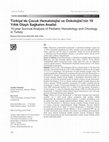
The Journal of Current Pediatrics, 2022
Giriş: Ülkemizde çocuklardaki hematolojik ve onkolojik hastalıklar; uygun tanı ve tedavi yöntemle... more Giriş: Ülkemizde çocuklardaki hematolojik ve onkolojik hastalıklar; uygun tanı ve tedavi yöntemleri uygulanmaz ise ölüm, sakatlık ve geç yan etkilerinin yüksek olması nedeniyle özel bir önem arz etmektedir. Türkiye'de Çocuk Hematolojisi ve Onkolojisi yan dal uzmanlığına yerleşme ve mezuniyet sonrası sürecin son 10 yılının analiz edilmesi amaçlanmıştır. Gereç ve Yöntem: Çocuk Hematolojisi ve Onkolojisi Uzmanlık Eğitimi Çekirdek Müfredatı, Yan Dal Uzmanlık Eğitimi Giriş Sınavı (YDUS), Devlet Hizmet Yükümlülüğü (DHY) Yerleşenler Listesi, isteğe bağlı iller arası yer değiştirme suretiyle atanma kuraları, Yükseköğretim Akademik Arama motoru ve Ek ödeme Yönetmeliği incelenmiştir.
Bulgular: Son 10 yılda, 340 kontenjanın 190'ına yerleşen olmuş ve 150 tanesi boş kalmıştır. Verisi incelenen ilk iki yılda %100 yerleştirme oranları son iki yıl içinde %7 ve %17'ye düşmüştür. Tüm merkezlere 10 yıllık ortalama yerleşme oranı %44 olarak hesaplanmıştır. Minimum 46, maksimum 85 puan ile Çocuk Hematolojisi ve Onkolojisi'ne yerleşme gerçekleşmiş olup tüm merkezlerin alım puan ortalaması 65 puan olmuştur. Ankara Çocuk Sağlığı ve Hastalıkları Hematoloji EAH, 16 yerleşme sayısı ile tüm merkezler içinde en yüksek yerleşme sayısını göstermiştir. İstanbul Tıp Fakültesi, 75 ile en yüksek ortalama puanla uzmanlık öğrencisi alan merkez olmuştur. ÖSYM tarafından yerleştirilen 212 kişiden asistanlık sürecini tamamlayan ve atanan 139 kişi tespit edilmiştir. Eş ve mazeret kurası dahil olmak üzere DHY kuralarında İstanbul (22) ve Ankara (16) başı çekmiş, Diyarbakır'a 12 kişi atanmış, 11 uzman ile Şanlıurfa takip etmiştir. YÖK veri tabanında Çocuk Hematolojisi ve Onkolojisi alanını bildiren toplam akademisyen sayısı 168 olup, profesör kadrosunda 98 kişi tespit edilmiştir.
Sonuç: Türkiye'de Çocuk Hematolojisi ve Onkolojisi branşının kan kaybettiği, özellikle son 3 yıldır tercih edilme oranlarında ciddi azalışlar olduğu bilinmektedir. Bu azalmanın tıp fakültesi eğitimi ve pediatri uzmanlığının seyri ile doğrusal bir ilişki yaşadığı değerlendirilmiştir. Şimdiye dek her yıl ortalama 14 Çocuk Hematolojisi ve Onkolojisi uzmanı yetişirken bundan sonraki süreçte 2-3 uzman yetişeceği öngörülmektedir. Sağlık Bakanlığı, Personel Dağılım Cetvelinde Türkiye'nin 41 ilinde 177 Çocuk Hematolojisi ve Onkolojisi uzmanı ile çalışacağını planlamıştır. Batman, Malatya ve Sivas'a öngörülen PDC'nin son 10 yılda 3 katı kadar uzman atanması, bazı illerde sorun olduğunu göstermektedir. 4924 sayılı Eleman Temininde Güçlük Çekilen Yerlerde Sözleşmeli Sağlık Personeli Çalıştırılmasına dair kanun kapsamında yandal uzmanı istihdam etmek çözüm yollarından biridir.
Introduction: Hematological and oncological diseases in children in our country; if appropriate diagnosis and treatment methods are not applied, it has particular importance due to the high rate of death, disability, and late side effects. It is aimed to analyze the last ten years of placement and post-graduation period in Pediatric Hematology and Oncology in Turkey. Materials and Methods: Pediatric Hematology and Oncology Specialization Education Core Curriculum, Minor Specialization Education Entrance Examination (YDUS), State Service Obligation (DHY) Settlement List, Optional rules for appointment by inter-provincial relocation, Higher Education Academic Search Engine and Additional Payment Regulations examined.
Results: In the last ten years, 190 of the 340 places have been settled, and 150 remain vacant. 100% placement rates in the first two years, the data of which were analyzed, decreased to 7% and 17% in the last two years. The 10-year average settlement rate in all centers was calculated as 44%. With a minimum score of 46 and a maximum score of 85, placement in Pediatric Hematology and Oncology was achieved, and the average score of all centers was 65 points. Out of 212 people placed by ÖSYM, 139 who completed the assistantship process and were appointed were identified. Istanbul (22) and Ankara (16) took the lead in DHY draws, including the Spouse and Excuse draw; 12 people were assigned to Diyarbakir, followed by Sanliurfa with 11 experts. The total number of academicians reporting the field of Pediatric Hematology and Oncology in the YÖK database is 168, and 98 professors have been identified.
Conclusion: While an average of 14 Pediatric Hematology and Oncology specialists have been trained every year until now, it is predicted that 2 to 3 specialists will be trained in the next period. The Ministry of Health has planned to work with 177 Pediatric Hematology and Oncology specialists in 41 provinces of Turkey in the Personnel Distribution Chart. The appointment of 3 times as many experts in the last ten years as the PDC envisaged in Batman, Malatya, and Sivas shows that there are problems in some provinces.
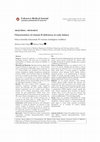
Characteristics of vitamin D deficiency in early infancy, 2022
Purpose: Vitamin D deficiency is a health problem in developing countries. This study aims to inv... more Purpose: Vitamin D deficiency is a health problem in developing countries. This study aims to investigate the characteristics of children with vitamin D deficiency in early infancy.
Materials and Methods: Hundred and forty infants with vitamin D deficiency (mean age:3.5 ± 1.7 [0-6] months) and a control group of 200 healthy infants (mean age: 3.4 ± 1.7 [0-6] months) were included in the study. Serum calcium, phosphorus, alkaline phosphatase, parathyroid hormone (PTH), and 25-hydroxyvitamin D (25(OH)D) levels were measured in the patient, control groups, and the mothers of the patients. In 38 patients, radiological findings were evaluated with knee and wrist radiographs. Thacher Rickets Severity Scoring (RSS) system was used for radiological evaluation of rickets severity.
Results: The most common (42%) complaints were respiratory symptoms, including cough, respiratory distress, and wheezing. The most common finding of physical examination was the rachitic rosary. Serum calcium (Ca++), alkaline phosphatase (ALP), 25(OH) vitamin D, and parathormone (PTH) levels were significantly different in the patient and the control groups. The mean Thacher radiological score of 38 patients was 3.1 ± 2.1 (0-8) points. The mother's dressing style of covering up the whole body, i.e., veiling, increased the infant's risk of vitamin D deficiency by 17.5 times.
Conclusion: Subtle clinical, laboratory, and radiological findings of vitamin D deficiency are detected in early infancy. Vitamin D deficiency should be considered primarily in infants with hypocalcemia whose mothers are less frequently exposed to sunlight due to geographical conditions and their preferred or imposed lifestyle.
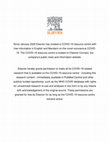
The Lancet Oncology, 2021
Background: Previous studies have shown that children and adolescents with COVID-19 generally hav... more Background: Previous studies have shown that children and adolescents with COVID-19 generally have mild disease. Children and adolescents with cancer, however, can have severe disease when infected with respiratory viruses. In this study, we aimed to understand the clinical course and outcomes of SARS-CoV-2 infection in children and adolescents with cancer.
Methods: We did a cohort study with data from 131 institutions in 45 countries. We created the Global Registry of COVID-19 in Childhood Cancer to capture de-identified data pertaining to laboratory-confirmed SARS-CoV-2 infections in children and adolescents (<19 years) with cancer or having received a haematopoietic stem-cell transplantation. There were no centre-specific exclusion criteria. The registry was disseminated through professional networks through email and conferences and health-care providers were invited to submit all qualifying cases. Data for demographics, oncological diagnosis, clinical course, and cancer therapy details were collected. Primary outcomes were disease severity and modification to cancer-directed therapy. The registry remains open to data collection.
Findings: Of 1520 submitted episodes, 1500 patients were included in the study between April 15, 2020, and Feb 1, 2021. 1319 patients had complete 30-day follow-up. 259 (19·9%) of 1301 patients had a severe or critical infection, and 50 (3·8%) of 1319 died with the cause attributed to COVID-19 infection. Modifications to cancer-directed therapy occurred in 609 (55·8%) of 1092 patients receiving active oncological treatment. Multivariable analysis revealed several factors associated with severe or critical illness, including World Bank low-income or lower-middle-income (odds ratio [OR] 5·8 [95% CI 3·8-8·8]; p<0·0001) and upper-middle-income (1·6 [1·2-2·2]; p=0·0024) country status; age 15-18 years (1·6 [1·1-2·2]; p=0·013); absolute lymphocyte count of 300 or less cells per mm3 (2·5 [1·8-3·4]; p<0·0001), absolute neutrophil count of 500 or less cells per mm3 (1·8 [1·3-2·4]; p=0·0001), and intensive treatment (1·8 [1·3-2·3]; p=0·0005). Factors associated with treatment modification included upper-middle-income country status (OR 0·5 [95% CI 0·3-0·7]; p=0·0004), primary diagnosis of other haematological malignancies (0·5 [0·3-0·8]; p=0·0088), the presence of one of more COVID-19 symptoms at the time of presentation (1·8 [1·3-2·4]; p=0·0002), and the presence of one or more comorbidities (1·6 [1·1-2·3]; p=0·020).
Interpretation: In this global cohort of children and adolescents with cancer and COVID-19, severe and critical illness occurred in one fifth of patients and deaths occurred in a higher proportion than is reported in the literature in the general paediatric population. Additionally, we found that variables associated with treatment modification were not the same as those associated with greater disease severity. These data could inform clinical practice guidelines and raise awareness globally that children and adolescents with cancer are at high-risk of developing severe COVID-19 illness.
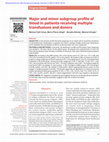
Asian Journal of Transfusion Science, 2022
Objective: It was aimed to profile the blood subgroups of our region and to reveal the prevalence... more Objective: It was aimed to profile the blood subgroups of our region and to reveal the prevalence of auto/alloimmune sensitization in patients who had to undergo multiple erythrocyte transfusions and to establish the sensitization profile by screening major and minor subgroups.
Materials and Methods: In this study, the distribution of ABO and Rh system major subgroups was studied in 100 donor blood. As the patient group, 50 patients who received three or more red blood cell transfusions were included. In addition to this group, Kell, Lewis, Duffy blood group systems were studied.
Results: According to the ABO system, 35% of the donors were in O, 33% in A, 17% in AB, and 15% in B. According to the Rh system, 75% is Dvi positive. Rh system is 99% e positive and 33% E positive in major subgroups and Kell1 positivity is 8%. In the patient group, 22% D(‑) was determined compared to Rh blood group. Among the major subgroups of Rh, C was 68%, E was 14%, c was 76%, and e positivity was found to be 100%. The Kell1 negativity rate is 96%. The highest negativity was found in 86% Lea antigen in Lewis system, in 36% S antigen in MNS system, 34% Fyb antigen in Duffy system, and 24% Jka antigen in Kidd system. When inappropriate blood is given for any antigen, a double population is formed. The double negativities we detected in our study occurred as follows according to blood group systems: E 18%, C 12%, c 8%, Cw 2%, Kell 1 2%, M 8%, N 4%, S 18%, s 6%, Fya 8%, Jka 6%, Jkb 22%. Indirect Agglutination Test (IAT) was negative in all patients.
Conclusion: IAT negativity in all patient groups suggests that we do not develop alloimmunization, but the high rates of double population suggest a high risk of alloimmunization.

Pediatric Blood & Cancer, 2022
Background and Aims: Acute respiratory tract infections (RTI) are a significant cause of morbidit... more Background and Aims: Acute respiratory tract infections (RTI) are a significant cause of morbidity and mortality in children with cancer; most are precipitated by viral infections. The aim of this study is to evaluate the nonCOVID-19 viral RTI during the COVID-19 pandemic in children with cancer.
Methods: In this multicenter (13centers) retrospective observational study, children and adolescents with cancer who presented with RTI symptoms between January 2020-March 2022 and who had viral RTI confirmed by multiplex polymerase chain reaction were evaluated according to demographic, etiological, clinical data and outcome.
Results: A total of 255 episodes in 212 children were evaluated. 32.1% of episodes occurred in a 16-month period between January 2020 and May 2021 during lockdowns and online distance learning in Turkey, and the remaining 67.8% in a 10-month period after the end of lockdowns and distance learning from May 2021 on. Lower RTI comprised 27.5% of episodes. The most common agents were Rhinovirus -Enterovirus (46.3%), Parainfluenza viruses (22.3%)which were detected throughout the year, Influenza viruses (9.8%), and Respiratory Syncytial Virus (RSV)(9.4%) which showed peaks in winter. Parainfluenza viruses, Adenovirus, RSV, and Influenza viruses were substantially associated with lower RTI with ratios of 47.3%, 36%, 29%, and 28%, respectively. Complete recovery was observed in 91.7% of episodes. Complications such as bacterial pneumonia (7.4%), multiple organ dysfunction (1.5%), myocarditis (1.1%), hepatitis (1.1%), and Guillain-Barre syndrome (0.7%) occurred in 8.6% of episodes. In a 30-day follow-up, nine patients died.
Conclusions: In children with cancer, the nonCOVID-19 viral RTI episodes were less frequent in the beginning of the pandemic during the lockdown and distance education period in comparison to later in the pandemic. Viral RTI, albeit in a few episodes, may cause morbidity and mortality in children with cancer; infection control and early diagnosis are crucial in preventing the spread of infection.
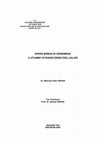
YÖK Tarama Merkezi, 2006
Clinical and biochemical parameter of rickets varies between early infancy and later childhood. H... more Clinical and biochemical parameter of rickets varies between early infancy and later childhood. However, there is not study describing clinical, biochemical and radiological findings of rickets in early infancy. In this study, we aimed to investigate the clinical, laboratory and socio-economic characteristics of 0–6 months old infants with rickets and their mothers. Study group included 140 infants (0–6 months old) having 25(OH) D levels less than 11 ng/mL. Control group consisted of age and sex matched 200 healthy infants. Clinical, biochemical and radiologic characteristics and risk factors for vitamin D deficiency were evaluated. Mean age of the infants was 3.5±1,7 months. Fifty-nine cases (42%) presented with respiratory symptoms and fifty-five (39%) cases with convulsion. Most of the infants (18.6%) had been born in January. Most of the infants (41.4%) were presented in spring season. Ninety-three point six persent of the mother denied vitamin D supplementation during pregnancy. Ninety-four point three percent of the babies had never been administered vitamin D. Eighty point seven percent of all mothers covered their heads outside the home and wear their hands and faces uncovered. Almost all of them (98.6%) spent most of their time indoors. Means±SD (min-max) of the biochemical parameters were as follow; Ca: 7.1±1.7 (4.0–11.0) mg/dL, P: 4.9±2.2 (0.7–16.4) mg/dL, ALP: 1062±707 (101–4267) U/L, 25(OH)D: 4.5±3.2 (0–11,0) ng/mL and PTH 261±273 (12–1940) pg/mL. Serum 25(OH)D levels were low (Mean:14.8 ng/mL) in 85,7% all the mothers. Thacher’s radiologic score was evaluated in 38 infants (Mean±SD: 3.1±2.1). Sixty-six point four percent of the infants presented with hypocalcemia. In conclusion, rickets in early infancy is mostly due to maternal vitamin D deficiency. İnfants in this period do not present with typical biochemical and radiologic features, hence, it is difficult to diagnose. Therefore deficiency of vitamin D must be kept in mind in infants presented with hypocalcemia.
Erken bebeklik dönemi riketsli vakalarla, klasik nutrisyonel vakalar arasında gerek klinik ve gerek biyokimyasal parametreler bakımından farklılık olduğu vaka raporlarında bildirilmektedir. Bununla birlikte erken dönem riketsli vakaların klinik, biyokimyasal ve radyolojik özelliklerini yansıtan geniş ölçekli bir çalışma mevcut değildir. Bu çalışmada amaç, yaşları 0–6 ay arasında değişen ve rikets tanısı alan bebeklerin ve annelerinin klinik özellikleri, laboratuar bulguları ve sosyoekonomik durumları gözden geçirilerek erken dönem rikets profilinin çıkarılmasıdır. Çeşitli nedenlerle getirilen 0–6 aylık yaş grubuna dâhil 25(OH)D düzeyi ≤11 ng/mL olan 140 vaka ve 25(OH)D düzeyi >11 ng/mL 200 sağlıklı bebek incelendi. D vitamini eksikliğine ait risk faktörleri, başvurudaki klinik, biyokimyasal ve radyolojik özellikleri değerlendirildi. Vakaların yaş ortalaması 3,5±1,7 ay idi. Vakaların 59’u (%42) solunum sistemi şikâyetleri, 55’i (%39) ise konvulziyon yakınması ile getirildi. Vakaların en fazla doğdukları ay %18,6 ile Ocak idi. En sık rikets tanısı konulan ay ise Nisan ayı idi. Vakaların %41,4’ü ilkbahar mevsiminde başvurdu. Vakaların %94,3’ünün vitamin D replasmanı almadığı ifade edildi. Annelerin %80,7’si ev dışında başı kapalı, yüz ve eller açık giyiniyor, %98,6’sı çalışmıyor ve vaktinin büyük bir kısmını evde geçiriyordu. Annelerin %93,6’sının gebelikte D vitamini kullanma öyküsü yok idi. Vakaların biyokimyasal parametreleri incelendiğinde ortalama Ca: 7,1±1,7 (4,0–11) mg/dL, P: 4,9±2,2 (0,7–16,4) mg/dL, ALP: 1062±707 (101–4267) U/L, 25(OH)D: 4,5±3,2 (0–11,0) ng/mL ve PTH 261±273 (12–1940) pg/mL idi. Annelerin %59,1’inin 25(OH)D düzeyi düşük (Ort: 14,8 ng/mL) idi. Rikets tanısında kullanılan bir radyolojik yöntem olan Thacher skoru açısından bakılan 38 vakanın ortalama skoru 3,1±2,1 (0–8) puan idi. Vakalarımızın %66,4’ünde hipokalsemi vardı. Sonuç olarak erken bebeklik dönemindeki riketsin büyük ölçüde maternal D vitamini yetersizliğine bağlı olduğu anlaşılmaktadır. Bu dönemdeki vakalarda tipik biyokimyasal ve radyolojik bulgular olmadığından dolayı tanıda güçlük yaşanmaktadır. Bu nedenle ülkemizde maternal D vitamini yetersizliği sık görüldüğünden erken bebeklik döneminde hipokalsemi ile başvuran olgularda ilk sırada D vitamini yetersizliği düşünülmelidir.
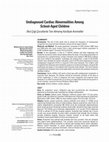
The Journal of Current Pediatrics, 2010
Introduction: The aim of this study was to assess the frequency of undiagnosed congenital and acq... more Introduction: The aim of this study was to assess the frequency of undiagnosed congenital and acquired heart diseases among school-aged children.
Materials and Method: The study population consisted of 4.370 children (2081 boys and 2289 girls) who were chosen from a total school-aged children population of 51,891 students (aged 7-15 years) (10.7±2.4) (8.4%).
Results: In this population, a total of 11 (0.25%) children had been diagnosed and treated for structural cardiac abnormalities before the study. In the study period (after an assessment by a questionmaire), cardiac evaluation was needed in 405 (9.3%) children who were invited to the pediatric cardiology unit. Among them, a total of 153 (37.8%) children were admitted for further evaluation, and 21 (13.7%) were diagnosed as having undiagnosed congenital (12.4%) or acquired (1.3%) heart diseases. Five children with congenital heart diseases were treated by surgical or invasive techniques, and penicillin prophylaxis was begun in two patients with rheumatic heart disease. The most frequent congenital heart diseases were atrial septal defect and mitral valve prolapse among the admitted children.
Conclusions: Some children still reach school age with undiagnosed congenital or acquired heart diseases. All children should be examined carefully at the time of school registration in order to diagnose and treat congenital and acquired heart diseases in an effort to prevent the occurrence of undesirable events during sports or social activities.
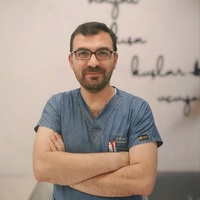




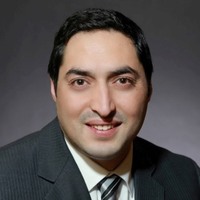




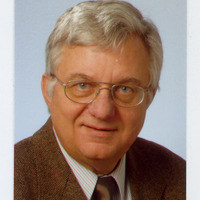
Uploads
Papers by Mehmet Fatih ORHAN
EP731/#838 Poster Topic: AS05 SIOP Scientific Program/AS05.r Epidemiology, Policy and Advocacy
Background and Aims: The earthquake disaster that occurred in 11 provinces of Turkey on February 6, 2023, affected all life. Patients with special needs like chilhood cancers and their doctors also affected. Our goal is to understand what we have lived, as PHO, how we handle the problems and understand special needs to be stronger and prepare such disasters.
Methods: A questionnaire has been send to TPOG members with 17 questions reliated to themselves and their families health conditions, their home, hospitals, patients, working and living conditions after 1 month of erthquake. Beside received their recommandations to be stronger and ready for the future possible disasters as PHO.
Results: Forty one Pediatric Hematologist/Oncologist (PHO) responded the questionnaire from 18 cities. 50% of the PHO that living outside of the earthquake cities have family members living at the earthquake region. Nine doctors that living at the earthquake region were able to quit their home while 1 had diffuculty to goout. Three of the doctors had damage at their homes. Seven of the doctors accommodated at tents, cars, hospitals or the their friends home. Eight of the doctors hospitals were damaged/collapsed. One of them worked at tent while others worked at solid buildings of the hospitals. Five doctors told they lost some patients while 60 % did not loose any and 30% did not know yet. Five doctors referred their patients to the other centers outside of the earthquake region or some bigger/solid hospitals near by themselves. 72% of the centers have received referral patients. Some of these patients accommadated at the hospitals, tents, dormitories and/or with their relatives.
Conclusions: As pediatric hematologist and oncologist, taking care of patient with special needs, we have to be prepared for disasters. For better coordination, we have to take place in the emergency management plan groups as PHO.
Bulgular: Son 10 yılda, 340 kontenjanın 190'ına yerleşen olmuş ve 150 tanesi boş kalmıştır. Verisi incelenen ilk iki yılda %100 yerleştirme oranları son iki yıl içinde %7 ve %17'ye düşmüştür. Tüm merkezlere 10 yıllık ortalama yerleşme oranı %44 olarak hesaplanmıştır. Minimum 46, maksimum 85 puan ile Çocuk Hematolojisi ve Onkolojisi'ne yerleşme gerçekleşmiş olup tüm merkezlerin alım puan ortalaması 65 puan olmuştur. Ankara Çocuk Sağlığı ve Hastalıkları Hematoloji EAH, 16 yerleşme sayısı ile tüm merkezler içinde en yüksek yerleşme sayısını göstermiştir. İstanbul Tıp Fakültesi, 75 ile en yüksek ortalama puanla uzmanlık öğrencisi alan merkez olmuştur. ÖSYM tarafından yerleştirilen 212 kişiden asistanlık sürecini tamamlayan ve atanan 139 kişi tespit edilmiştir. Eş ve mazeret kurası dahil olmak üzere DHY kuralarında İstanbul (22) ve Ankara (16) başı çekmiş, Diyarbakır'a 12 kişi atanmış, 11 uzman ile Şanlıurfa takip etmiştir. YÖK veri tabanında Çocuk Hematolojisi ve Onkolojisi alanını bildiren toplam akademisyen sayısı 168 olup, profesör kadrosunda 98 kişi tespit edilmiştir.
Sonuç: Türkiye'de Çocuk Hematolojisi ve Onkolojisi branşının kan kaybettiği, özellikle son 3 yıldır tercih edilme oranlarında ciddi azalışlar olduğu bilinmektedir. Bu azalmanın tıp fakültesi eğitimi ve pediatri uzmanlığının seyri ile doğrusal bir ilişki yaşadığı değerlendirilmiştir. Şimdiye dek her yıl ortalama 14 Çocuk Hematolojisi ve Onkolojisi uzmanı yetişirken bundan sonraki süreçte 2-3 uzman yetişeceği öngörülmektedir. Sağlık Bakanlığı, Personel Dağılım Cetvelinde Türkiye'nin 41 ilinde 177 Çocuk Hematolojisi ve Onkolojisi uzmanı ile çalışacağını planlamıştır. Batman, Malatya ve Sivas'a öngörülen PDC'nin son 10 yılda 3 katı kadar uzman atanması, bazı illerde sorun olduğunu göstermektedir. 4924 sayılı Eleman Temininde Güçlük Çekilen Yerlerde Sözleşmeli Sağlık Personeli Çalıştırılmasına dair kanun kapsamında yandal uzmanı istihdam etmek çözüm yollarından biridir.
Introduction: Hematological and oncological diseases in children in our country; if appropriate diagnosis and treatment methods are not applied, it has particular importance due to the high rate of death, disability, and late side effects. It is aimed to analyze the last ten years of placement and post-graduation period in Pediatric Hematology and Oncology in Turkey. Materials and Methods: Pediatric Hematology and Oncology Specialization Education Core Curriculum, Minor Specialization Education Entrance Examination (YDUS), State Service Obligation (DHY) Settlement List, Optional rules for appointment by inter-provincial relocation, Higher Education Academic Search Engine and Additional Payment Regulations examined.
Results: In the last ten years, 190 of the 340 places have been settled, and 150 remain vacant. 100% placement rates in the first two years, the data of which were analyzed, decreased to 7% and 17% in the last two years. The 10-year average settlement rate in all centers was calculated as 44%. With a minimum score of 46 and a maximum score of 85, placement in Pediatric Hematology and Oncology was achieved, and the average score of all centers was 65 points. Out of 212 people placed by ÖSYM, 139 who completed the assistantship process and were appointed were identified. Istanbul (22) and Ankara (16) took the lead in DHY draws, including the Spouse and Excuse draw; 12 people were assigned to Diyarbakir, followed by Sanliurfa with 11 experts. The total number of academicians reporting the field of Pediatric Hematology and Oncology in the YÖK database is 168, and 98 professors have been identified.
Conclusion: While an average of 14 Pediatric Hematology and Oncology specialists have been trained every year until now, it is predicted that 2 to 3 specialists will be trained in the next period. The Ministry of Health has planned to work with 177 Pediatric Hematology and Oncology specialists in 41 provinces of Turkey in the Personnel Distribution Chart. The appointment of 3 times as many experts in the last ten years as the PDC envisaged in Batman, Malatya, and Sivas shows that there are problems in some provinces.
Materials and Methods: Hundred and forty infants with vitamin D deficiency (mean age:3.5 ± 1.7 [0-6] months) and a control group of 200 healthy infants (mean age: 3.4 ± 1.7 [0-6] months) were included in the study. Serum calcium, phosphorus, alkaline phosphatase, parathyroid hormone (PTH), and 25-hydroxyvitamin D (25(OH)D) levels were measured in the patient, control groups, and the mothers of the patients. In 38 patients, radiological findings were evaluated with knee and wrist radiographs. Thacher Rickets Severity Scoring (RSS) system was used for radiological evaluation of rickets severity.
Results: The most common (42%) complaints were respiratory symptoms, including cough, respiratory distress, and wheezing. The most common finding of physical examination was the rachitic rosary. Serum calcium (Ca++), alkaline phosphatase (ALP), 25(OH) vitamin D, and parathormone (PTH) levels were significantly different in the patient and the control groups. The mean Thacher radiological score of 38 patients was 3.1 ± 2.1 (0-8) points. The mother's dressing style of covering up the whole body, i.e., veiling, increased the infant's risk of vitamin D deficiency by 17.5 times.
Conclusion: Subtle clinical, laboratory, and radiological findings of vitamin D deficiency are detected in early infancy. Vitamin D deficiency should be considered primarily in infants with hypocalcemia whose mothers are less frequently exposed to sunlight due to geographical conditions and their preferred or imposed lifestyle.
Methods: We did a cohort study with data from 131 institutions in 45 countries. We created the Global Registry of COVID-19 in Childhood Cancer to capture de-identified data pertaining to laboratory-confirmed SARS-CoV-2 infections in children and adolescents (<19 years) with cancer or having received a haematopoietic stem-cell transplantation. There were no centre-specific exclusion criteria. The registry was disseminated through professional networks through email and conferences and health-care providers were invited to submit all qualifying cases. Data for demographics, oncological diagnosis, clinical course, and cancer therapy details were collected. Primary outcomes were disease severity and modification to cancer-directed therapy. The registry remains open to data collection.
Findings: Of 1520 submitted episodes, 1500 patients were included in the study between April 15, 2020, and Feb 1, 2021. 1319 patients had complete 30-day follow-up. 259 (19·9%) of 1301 patients had a severe or critical infection, and 50 (3·8%) of 1319 died with the cause attributed to COVID-19 infection. Modifications to cancer-directed therapy occurred in 609 (55·8%) of 1092 patients receiving active oncological treatment. Multivariable analysis revealed several factors associated with severe or critical illness, including World Bank low-income or lower-middle-income (odds ratio [OR] 5·8 [95% CI 3·8-8·8]; p<0·0001) and upper-middle-income (1·6 [1·2-2·2]; p=0·0024) country status; age 15-18 years (1·6 [1·1-2·2]; p=0·013); absolute lymphocyte count of 300 or less cells per mm3 (2·5 [1·8-3·4]; p<0·0001), absolute neutrophil count of 500 or less cells per mm3 (1·8 [1·3-2·4]; p=0·0001), and intensive treatment (1·8 [1·3-2·3]; p=0·0005). Factors associated with treatment modification included upper-middle-income country status (OR 0·5 [95% CI 0·3-0·7]; p=0·0004), primary diagnosis of other haematological malignancies (0·5 [0·3-0·8]; p=0·0088), the presence of one of more COVID-19 symptoms at the time of presentation (1·8 [1·3-2·4]; p=0·0002), and the presence of one or more comorbidities (1·6 [1·1-2·3]; p=0·020).
Interpretation: In this global cohort of children and adolescents with cancer and COVID-19, severe and critical illness occurred in one fifth of patients and deaths occurred in a higher proportion than is reported in the literature in the general paediatric population. Additionally, we found that variables associated with treatment modification were not the same as those associated with greater disease severity. These data could inform clinical practice guidelines and raise awareness globally that children and adolescents with cancer are at high-risk of developing severe COVID-19 illness.
Materials and Methods: In this study, the distribution of ABO and Rh system major subgroups was studied in 100 donor blood. As the patient group, 50 patients who received three or more red blood cell transfusions were included. In addition to this group, Kell, Lewis, Duffy blood group systems were studied.
Results: According to the ABO system, 35% of the donors were in O, 33% in A, 17% in AB, and 15% in B. According to the Rh system, 75% is Dvi positive. Rh system is 99% e positive and 33% E positive in major subgroups and Kell1 positivity is 8%. In the patient group, 22% D(‑) was determined compared to Rh blood group. Among the major subgroups of Rh, C was 68%, E was 14%, c was 76%, and e positivity was found to be 100%. The Kell1 negativity rate is 96%. The highest negativity was found in 86% Lea antigen in Lewis system, in 36% S antigen in MNS system, 34% Fyb antigen in Duffy system, and 24% Jka antigen in Kidd system. When inappropriate blood is given for any antigen, a double population is formed. The double negativities we detected in our study occurred as follows according to blood group systems: E 18%, C 12%, c 8%, Cw 2%, Kell 1 2%, M 8%, N 4%, S 18%, s 6%, Fya 8%, Jka 6%, Jkb 22%. Indirect Agglutination Test (IAT) was negative in all patients.
Conclusion: IAT negativity in all patient groups suggests that we do not develop alloimmunization, but the high rates of double population suggest a high risk of alloimmunization.
Methods: In this multicenter (13centers) retrospective observational study, children and adolescents with cancer who presented with RTI symptoms between January 2020-March 2022 and who had viral RTI confirmed by multiplex polymerase chain reaction were evaluated according to demographic, etiological, clinical data and outcome.
Results: A total of 255 episodes in 212 children were evaluated. 32.1% of episodes occurred in a 16-month period between January 2020 and May 2021 during lockdowns and online distance learning in Turkey, and the remaining 67.8% in a 10-month period after the end of lockdowns and distance learning from May 2021 on. Lower RTI comprised 27.5% of episodes. The most common agents were Rhinovirus -Enterovirus (46.3%), Parainfluenza viruses (22.3%)which were detected throughout the year, Influenza viruses (9.8%), and Respiratory Syncytial Virus (RSV)(9.4%) which showed peaks in winter. Parainfluenza viruses, Adenovirus, RSV, and Influenza viruses were substantially associated with lower RTI with ratios of 47.3%, 36%, 29%, and 28%, respectively. Complete recovery was observed in 91.7% of episodes. Complications such as bacterial pneumonia (7.4%), multiple organ dysfunction (1.5%), myocarditis (1.1%), hepatitis (1.1%), and Guillain-Barre syndrome (0.7%) occurred in 8.6% of episodes. In a 30-day follow-up, nine patients died.
Conclusions: In children with cancer, the nonCOVID-19 viral RTI episodes were less frequent in the beginning of the pandemic during the lockdown and distance education period in comparison to later in the pandemic. Viral RTI, albeit in a few episodes, may cause morbidity and mortality in children with cancer; infection control and early diagnosis are crucial in preventing the spread of infection.
Erken bebeklik dönemi riketsli vakalarla, klasik nutrisyonel vakalar arasında gerek klinik ve gerek biyokimyasal parametreler bakımından farklılık olduğu vaka raporlarında bildirilmektedir. Bununla birlikte erken dönem riketsli vakaların klinik, biyokimyasal ve radyolojik özelliklerini yansıtan geniş ölçekli bir çalışma mevcut değildir. Bu çalışmada amaç, yaşları 0–6 ay arasında değişen ve rikets tanısı alan bebeklerin ve annelerinin klinik özellikleri, laboratuar bulguları ve sosyoekonomik durumları gözden geçirilerek erken dönem rikets profilinin çıkarılmasıdır. Çeşitli nedenlerle getirilen 0–6 aylık yaş grubuna dâhil 25(OH)D düzeyi ≤11 ng/mL olan 140 vaka ve 25(OH)D düzeyi >11 ng/mL 200 sağlıklı bebek incelendi. D vitamini eksikliğine ait risk faktörleri, başvurudaki klinik, biyokimyasal ve radyolojik özellikleri değerlendirildi. Vakaların yaş ortalaması 3,5±1,7 ay idi. Vakaların 59’u (%42) solunum sistemi şikâyetleri, 55’i (%39) ise konvulziyon yakınması ile getirildi. Vakaların en fazla doğdukları ay %18,6 ile Ocak idi. En sık rikets tanısı konulan ay ise Nisan ayı idi. Vakaların %41,4’ü ilkbahar mevsiminde başvurdu. Vakaların %94,3’ünün vitamin D replasmanı almadığı ifade edildi. Annelerin %80,7’si ev dışında başı kapalı, yüz ve eller açık giyiniyor, %98,6’sı çalışmıyor ve vaktinin büyük bir kısmını evde geçiriyordu. Annelerin %93,6’sının gebelikte D vitamini kullanma öyküsü yok idi. Vakaların biyokimyasal parametreleri incelendiğinde ortalama Ca: 7,1±1,7 (4,0–11) mg/dL, P: 4,9±2,2 (0,7–16,4) mg/dL, ALP: 1062±707 (101–4267) U/L, 25(OH)D: 4,5±3,2 (0–11,0) ng/mL ve PTH 261±273 (12–1940) pg/mL idi. Annelerin %59,1’inin 25(OH)D düzeyi düşük (Ort: 14,8 ng/mL) idi. Rikets tanısında kullanılan bir radyolojik yöntem olan Thacher skoru açısından bakılan 38 vakanın ortalama skoru 3,1±2,1 (0–8) puan idi. Vakalarımızın %66,4’ünde hipokalsemi vardı. Sonuç olarak erken bebeklik dönemindeki riketsin büyük ölçüde maternal D vitamini yetersizliğine bağlı olduğu anlaşılmaktadır. Bu dönemdeki vakalarda tipik biyokimyasal ve radyolojik bulgular olmadığından dolayı tanıda güçlük yaşanmaktadır. Bu nedenle ülkemizde maternal D vitamini yetersizliği sık görüldüğünden erken bebeklik döneminde hipokalsemi ile başvuran olgularda ilk sırada D vitamini yetersizliği düşünülmelidir.
Materials and Method: The study population consisted of 4.370 children (2081 boys and 2289 girls) who were chosen from a total school-aged children population of 51,891 students (aged 7-15 years) (10.7±2.4) (8.4%).
Results: In this population, a total of 11 (0.25%) children had been diagnosed and treated for structural cardiac abnormalities before the study. In the study period (after an assessment by a questionmaire), cardiac evaluation was needed in 405 (9.3%) children who were invited to the pediatric cardiology unit. Among them, a total of 153 (37.8%) children were admitted for further evaluation, and 21 (13.7%) were diagnosed as having undiagnosed congenital (12.4%) or acquired (1.3%) heart diseases. Five children with congenital heart diseases were treated by surgical or invasive techniques, and penicillin prophylaxis was begun in two patients with rheumatic heart disease. The most frequent congenital heart diseases were atrial septal defect and mitral valve prolapse among the admitted children.
Conclusions: Some children still reach school age with undiagnosed congenital or acquired heart diseases. All children should be examined carefully at the time of school registration in order to diagnose and treat congenital and acquired heart diseases in an effort to prevent the occurrence of undesirable events during sports or social activities.
EP731/#838 Poster Topic: AS05 SIOP Scientific Program/AS05.r Epidemiology, Policy and Advocacy
Background and Aims: The earthquake disaster that occurred in 11 provinces of Turkey on February 6, 2023, affected all life. Patients with special needs like chilhood cancers and their doctors also affected. Our goal is to understand what we have lived, as PHO, how we handle the problems and understand special needs to be stronger and prepare such disasters.
Methods: A questionnaire has been send to TPOG members with 17 questions reliated to themselves and their families health conditions, their home, hospitals, patients, working and living conditions after 1 month of erthquake. Beside received their recommandations to be stronger and ready for the future possible disasters as PHO.
Results: Forty one Pediatric Hematologist/Oncologist (PHO) responded the questionnaire from 18 cities. 50% of the PHO that living outside of the earthquake cities have family members living at the earthquake region. Nine doctors that living at the earthquake region were able to quit their home while 1 had diffuculty to goout. Three of the doctors had damage at their homes. Seven of the doctors accommodated at tents, cars, hospitals or the their friends home. Eight of the doctors hospitals were damaged/collapsed. One of them worked at tent while others worked at solid buildings of the hospitals. Five doctors told they lost some patients while 60 % did not loose any and 30% did not know yet. Five doctors referred their patients to the other centers outside of the earthquake region or some bigger/solid hospitals near by themselves. 72% of the centers have received referral patients. Some of these patients accommadated at the hospitals, tents, dormitories and/or with their relatives.
Conclusions: As pediatric hematologist and oncologist, taking care of patient with special needs, we have to be prepared for disasters. For better coordination, we have to take place in the emergency management plan groups as PHO.
Bulgular: Son 10 yılda, 340 kontenjanın 190'ına yerleşen olmuş ve 150 tanesi boş kalmıştır. Verisi incelenen ilk iki yılda %100 yerleştirme oranları son iki yıl içinde %7 ve %17'ye düşmüştür. Tüm merkezlere 10 yıllık ortalama yerleşme oranı %44 olarak hesaplanmıştır. Minimum 46, maksimum 85 puan ile Çocuk Hematolojisi ve Onkolojisi'ne yerleşme gerçekleşmiş olup tüm merkezlerin alım puan ortalaması 65 puan olmuştur. Ankara Çocuk Sağlığı ve Hastalıkları Hematoloji EAH, 16 yerleşme sayısı ile tüm merkezler içinde en yüksek yerleşme sayısını göstermiştir. İstanbul Tıp Fakültesi, 75 ile en yüksek ortalama puanla uzmanlık öğrencisi alan merkez olmuştur. ÖSYM tarafından yerleştirilen 212 kişiden asistanlık sürecini tamamlayan ve atanan 139 kişi tespit edilmiştir. Eş ve mazeret kurası dahil olmak üzere DHY kuralarında İstanbul (22) ve Ankara (16) başı çekmiş, Diyarbakır'a 12 kişi atanmış, 11 uzman ile Şanlıurfa takip etmiştir. YÖK veri tabanında Çocuk Hematolojisi ve Onkolojisi alanını bildiren toplam akademisyen sayısı 168 olup, profesör kadrosunda 98 kişi tespit edilmiştir.
Sonuç: Türkiye'de Çocuk Hematolojisi ve Onkolojisi branşının kan kaybettiği, özellikle son 3 yıldır tercih edilme oranlarında ciddi azalışlar olduğu bilinmektedir. Bu azalmanın tıp fakültesi eğitimi ve pediatri uzmanlığının seyri ile doğrusal bir ilişki yaşadığı değerlendirilmiştir. Şimdiye dek her yıl ortalama 14 Çocuk Hematolojisi ve Onkolojisi uzmanı yetişirken bundan sonraki süreçte 2-3 uzman yetişeceği öngörülmektedir. Sağlık Bakanlığı, Personel Dağılım Cetvelinde Türkiye'nin 41 ilinde 177 Çocuk Hematolojisi ve Onkolojisi uzmanı ile çalışacağını planlamıştır. Batman, Malatya ve Sivas'a öngörülen PDC'nin son 10 yılda 3 katı kadar uzman atanması, bazı illerde sorun olduğunu göstermektedir. 4924 sayılı Eleman Temininde Güçlük Çekilen Yerlerde Sözleşmeli Sağlık Personeli Çalıştırılmasına dair kanun kapsamında yandal uzmanı istihdam etmek çözüm yollarından biridir.
Introduction: Hematological and oncological diseases in children in our country; if appropriate diagnosis and treatment methods are not applied, it has particular importance due to the high rate of death, disability, and late side effects. It is aimed to analyze the last ten years of placement and post-graduation period in Pediatric Hematology and Oncology in Turkey. Materials and Methods: Pediatric Hematology and Oncology Specialization Education Core Curriculum, Minor Specialization Education Entrance Examination (YDUS), State Service Obligation (DHY) Settlement List, Optional rules for appointment by inter-provincial relocation, Higher Education Academic Search Engine and Additional Payment Regulations examined.
Results: In the last ten years, 190 of the 340 places have been settled, and 150 remain vacant. 100% placement rates in the first two years, the data of which were analyzed, decreased to 7% and 17% in the last two years. The 10-year average settlement rate in all centers was calculated as 44%. With a minimum score of 46 and a maximum score of 85, placement in Pediatric Hematology and Oncology was achieved, and the average score of all centers was 65 points. Out of 212 people placed by ÖSYM, 139 who completed the assistantship process and were appointed were identified. Istanbul (22) and Ankara (16) took the lead in DHY draws, including the Spouse and Excuse draw; 12 people were assigned to Diyarbakir, followed by Sanliurfa with 11 experts. The total number of academicians reporting the field of Pediatric Hematology and Oncology in the YÖK database is 168, and 98 professors have been identified.
Conclusion: While an average of 14 Pediatric Hematology and Oncology specialists have been trained every year until now, it is predicted that 2 to 3 specialists will be trained in the next period. The Ministry of Health has planned to work with 177 Pediatric Hematology and Oncology specialists in 41 provinces of Turkey in the Personnel Distribution Chart. The appointment of 3 times as many experts in the last ten years as the PDC envisaged in Batman, Malatya, and Sivas shows that there are problems in some provinces.
Materials and Methods: Hundred and forty infants with vitamin D deficiency (mean age:3.5 ± 1.7 [0-6] months) and a control group of 200 healthy infants (mean age: 3.4 ± 1.7 [0-6] months) were included in the study. Serum calcium, phosphorus, alkaline phosphatase, parathyroid hormone (PTH), and 25-hydroxyvitamin D (25(OH)D) levels were measured in the patient, control groups, and the mothers of the patients. In 38 patients, radiological findings were evaluated with knee and wrist radiographs. Thacher Rickets Severity Scoring (RSS) system was used for radiological evaluation of rickets severity.
Results: The most common (42%) complaints were respiratory symptoms, including cough, respiratory distress, and wheezing. The most common finding of physical examination was the rachitic rosary. Serum calcium (Ca++), alkaline phosphatase (ALP), 25(OH) vitamin D, and parathormone (PTH) levels were significantly different in the patient and the control groups. The mean Thacher radiological score of 38 patients was 3.1 ± 2.1 (0-8) points. The mother's dressing style of covering up the whole body, i.e., veiling, increased the infant's risk of vitamin D deficiency by 17.5 times.
Conclusion: Subtle clinical, laboratory, and radiological findings of vitamin D deficiency are detected in early infancy. Vitamin D deficiency should be considered primarily in infants with hypocalcemia whose mothers are less frequently exposed to sunlight due to geographical conditions and their preferred or imposed lifestyle.
Methods: We did a cohort study with data from 131 institutions in 45 countries. We created the Global Registry of COVID-19 in Childhood Cancer to capture de-identified data pertaining to laboratory-confirmed SARS-CoV-2 infections in children and adolescents (<19 years) with cancer or having received a haematopoietic stem-cell transplantation. There were no centre-specific exclusion criteria. The registry was disseminated through professional networks through email and conferences and health-care providers were invited to submit all qualifying cases. Data for demographics, oncological diagnosis, clinical course, and cancer therapy details were collected. Primary outcomes were disease severity and modification to cancer-directed therapy. The registry remains open to data collection.
Findings: Of 1520 submitted episodes, 1500 patients were included in the study between April 15, 2020, and Feb 1, 2021. 1319 patients had complete 30-day follow-up. 259 (19·9%) of 1301 patients had a severe or critical infection, and 50 (3·8%) of 1319 died with the cause attributed to COVID-19 infection. Modifications to cancer-directed therapy occurred in 609 (55·8%) of 1092 patients receiving active oncological treatment. Multivariable analysis revealed several factors associated with severe or critical illness, including World Bank low-income or lower-middle-income (odds ratio [OR] 5·8 [95% CI 3·8-8·8]; p<0·0001) and upper-middle-income (1·6 [1·2-2·2]; p=0·0024) country status; age 15-18 years (1·6 [1·1-2·2]; p=0·013); absolute lymphocyte count of 300 or less cells per mm3 (2·5 [1·8-3·4]; p<0·0001), absolute neutrophil count of 500 or less cells per mm3 (1·8 [1·3-2·4]; p=0·0001), and intensive treatment (1·8 [1·3-2·3]; p=0·0005). Factors associated with treatment modification included upper-middle-income country status (OR 0·5 [95% CI 0·3-0·7]; p=0·0004), primary diagnosis of other haematological malignancies (0·5 [0·3-0·8]; p=0·0088), the presence of one of more COVID-19 symptoms at the time of presentation (1·8 [1·3-2·4]; p=0·0002), and the presence of one or more comorbidities (1·6 [1·1-2·3]; p=0·020).
Interpretation: In this global cohort of children and adolescents with cancer and COVID-19, severe and critical illness occurred in one fifth of patients and deaths occurred in a higher proportion than is reported in the literature in the general paediatric population. Additionally, we found that variables associated with treatment modification were not the same as those associated with greater disease severity. These data could inform clinical practice guidelines and raise awareness globally that children and adolescents with cancer are at high-risk of developing severe COVID-19 illness.
Materials and Methods: In this study, the distribution of ABO and Rh system major subgroups was studied in 100 donor blood. As the patient group, 50 patients who received three or more red blood cell transfusions were included. In addition to this group, Kell, Lewis, Duffy blood group systems were studied.
Results: According to the ABO system, 35% of the donors were in O, 33% in A, 17% in AB, and 15% in B. According to the Rh system, 75% is Dvi positive. Rh system is 99% e positive and 33% E positive in major subgroups and Kell1 positivity is 8%. In the patient group, 22% D(‑) was determined compared to Rh blood group. Among the major subgroups of Rh, C was 68%, E was 14%, c was 76%, and e positivity was found to be 100%. The Kell1 negativity rate is 96%. The highest negativity was found in 86% Lea antigen in Lewis system, in 36% S antigen in MNS system, 34% Fyb antigen in Duffy system, and 24% Jka antigen in Kidd system. When inappropriate blood is given for any antigen, a double population is formed. The double negativities we detected in our study occurred as follows according to blood group systems: E 18%, C 12%, c 8%, Cw 2%, Kell 1 2%, M 8%, N 4%, S 18%, s 6%, Fya 8%, Jka 6%, Jkb 22%. Indirect Agglutination Test (IAT) was negative in all patients.
Conclusion: IAT negativity in all patient groups suggests that we do not develop alloimmunization, but the high rates of double population suggest a high risk of alloimmunization.
Methods: In this multicenter (13centers) retrospective observational study, children and adolescents with cancer who presented with RTI symptoms between January 2020-March 2022 and who had viral RTI confirmed by multiplex polymerase chain reaction were evaluated according to demographic, etiological, clinical data and outcome.
Results: A total of 255 episodes in 212 children were evaluated. 32.1% of episodes occurred in a 16-month period between January 2020 and May 2021 during lockdowns and online distance learning in Turkey, and the remaining 67.8% in a 10-month period after the end of lockdowns and distance learning from May 2021 on. Lower RTI comprised 27.5% of episodes. The most common agents were Rhinovirus -Enterovirus (46.3%), Parainfluenza viruses (22.3%)which were detected throughout the year, Influenza viruses (9.8%), and Respiratory Syncytial Virus (RSV)(9.4%) which showed peaks in winter. Parainfluenza viruses, Adenovirus, RSV, and Influenza viruses were substantially associated with lower RTI with ratios of 47.3%, 36%, 29%, and 28%, respectively. Complete recovery was observed in 91.7% of episodes. Complications such as bacterial pneumonia (7.4%), multiple organ dysfunction (1.5%), myocarditis (1.1%), hepatitis (1.1%), and Guillain-Barre syndrome (0.7%) occurred in 8.6% of episodes. In a 30-day follow-up, nine patients died.
Conclusions: In children with cancer, the nonCOVID-19 viral RTI episodes were less frequent in the beginning of the pandemic during the lockdown and distance education period in comparison to later in the pandemic. Viral RTI, albeit in a few episodes, may cause morbidity and mortality in children with cancer; infection control and early diagnosis are crucial in preventing the spread of infection.
Erken bebeklik dönemi riketsli vakalarla, klasik nutrisyonel vakalar arasında gerek klinik ve gerek biyokimyasal parametreler bakımından farklılık olduğu vaka raporlarında bildirilmektedir. Bununla birlikte erken dönem riketsli vakaların klinik, biyokimyasal ve radyolojik özelliklerini yansıtan geniş ölçekli bir çalışma mevcut değildir. Bu çalışmada amaç, yaşları 0–6 ay arasında değişen ve rikets tanısı alan bebeklerin ve annelerinin klinik özellikleri, laboratuar bulguları ve sosyoekonomik durumları gözden geçirilerek erken dönem rikets profilinin çıkarılmasıdır. Çeşitli nedenlerle getirilen 0–6 aylık yaş grubuna dâhil 25(OH)D düzeyi ≤11 ng/mL olan 140 vaka ve 25(OH)D düzeyi >11 ng/mL 200 sağlıklı bebek incelendi. D vitamini eksikliğine ait risk faktörleri, başvurudaki klinik, biyokimyasal ve radyolojik özellikleri değerlendirildi. Vakaların yaş ortalaması 3,5±1,7 ay idi. Vakaların 59’u (%42) solunum sistemi şikâyetleri, 55’i (%39) ise konvulziyon yakınması ile getirildi. Vakaların en fazla doğdukları ay %18,6 ile Ocak idi. En sık rikets tanısı konulan ay ise Nisan ayı idi. Vakaların %41,4’ü ilkbahar mevsiminde başvurdu. Vakaların %94,3’ünün vitamin D replasmanı almadığı ifade edildi. Annelerin %80,7’si ev dışında başı kapalı, yüz ve eller açık giyiniyor, %98,6’sı çalışmıyor ve vaktinin büyük bir kısmını evde geçiriyordu. Annelerin %93,6’sının gebelikte D vitamini kullanma öyküsü yok idi. Vakaların biyokimyasal parametreleri incelendiğinde ortalama Ca: 7,1±1,7 (4,0–11) mg/dL, P: 4,9±2,2 (0,7–16,4) mg/dL, ALP: 1062±707 (101–4267) U/L, 25(OH)D: 4,5±3,2 (0–11,0) ng/mL ve PTH 261±273 (12–1940) pg/mL idi. Annelerin %59,1’inin 25(OH)D düzeyi düşük (Ort: 14,8 ng/mL) idi. Rikets tanısında kullanılan bir radyolojik yöntem olan Thacher skoru açısından bakılan 38 vakanın ortalama skoru 3,1±2,1 (0–8) puan idi. Vakalarımızın %66,4’ünde hipokalsemi vardı. Sonuç olarak erken bebeklik dönemindeki riketsin büyük ölçüde maternal D vitamini yetersizliğine bağlı olduğu anlaşılmaktadır. Bu dönemdeki vakalarda tipik biyokimyasal ve radyolojik bulgular olmadığından dolayı tanıda güçlük yaşanmaktadır. Bu nedenle ülkemizde maternal D vitamini yetersizliği sık görüldüğünden erken bebeklik döneminde hipokalsemi ile başvuran olgularda ilk sırada D vitamini yetersizliği düşünülmelidir.
Materials and Method: The study population consisted of 4.370 children (2081 boys and 2289 girls) who were chosen from a total school-aged children population of 51,891 students (aged 7-15 years) (10.7±2.4) (8.4%).
Results: In this population, a total of 11 (0.25%) children had been diagnosed and treated for structural cardiac abnormalities before the study. In the study period (after an assessment by a questionmaire), cardiac evaluation was needed in 405 (9.3%) children who were invited to the pediatric cardiology unit. Among them, a total of 153 (37.8%) children were admitted for further evaluation, and 21 (13.7%) were diagnosed as having undiagnosed congenital (12.4%) or acquired (1.3%) heart diseases. Five children with congenital heart diseases were treated by surgical or invasive techniques, and penicillin prophylaxis was begun in two patients with rheumatic heart disease. The most frequent congenital heart diseases were atrial septal defect and mitral valve prolapse among the admitted children.
Conclusions: Some children still reach school age with undiagnosed congenital or acquired heart diseases. All children should be examined carefully at the time of school registration in order to diagnose and treat congenital and acquired heart diseases in an effort to prevent the occurrence of undesirable events during sports or social activities.
Yöntem: Aralık 2022 - Eylül 2023 tarihleri arasında, Ege Üniversitesi Tıp Fakültesi Çocuk Genetik Hastalıkları Bilim Dalında, FXI eksikliği ön tanısıyla 57 gen içeren koagülopati paneli çalışılan ve F11 geninde patojenik varyant saptanan 12 aileden 14 olgunun klinik bulguları, aPTT ve FXI seviyeleri ile
moleküler analiz sonuçları incelenmiştir.
Bulgu: Olguların 9'u kadın, 5'i erkek olup yaşları 2 ile 67 arasında değişmektedir. FXI seviyeleri %0,9 ile %34 arasında, aPTT süreleri 36 ile 105 saniye arasında değişmektedir. F11 geninde 1'i splicing, 2'si
nonsense, 7'si missense olmak üzere 10 farklı patojenik varyant tespit edilmiştir. Bu varyantlardan c.1759T>C (p.Trp587Arg) varyantı daha önce literatürde bildirilmemiştir. Patojenik varyantlar 12 olguda biallelik, 2 olguda monoallelik olarak bulunmuştur.
Sonuç: Bu çalışma ile F11 eksikliğinin genotip ve fenotip özellikleri genişletilmiş ve literatürde daha önce bildirilmemiş yeni bir varyant sunulmuştur. Bu alandaki bilgi birikiminin artması, nadir görülen bir
kanama bozukluğunun hasta yönetimini iyileştirecektir.